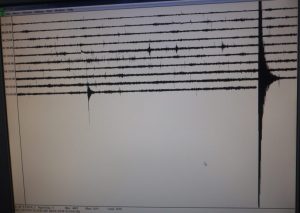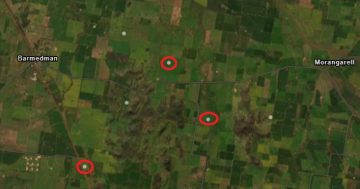
A screenshot from earthquake scientist Marion Leiba’s home seismograph. Photo: Supplied.
A minor earthquake has shaken some parts of Canberra this morning. Geoscience Australia has registered a 3.1 magnitude earthquake has been in the Canberra region at a depth of 10km. The main shock appears to have occurred at 10:05 am.
Earthquake scientist Marion Leiba observed the quake and an aftershock on her home seismograph in Kambah and says “it was a beauty”. She noted a mild aftershock around 12 minutes after the main event, at 10.17 and says it had a 1.5 magnitude.
Geoscience Australia has pinpointed the epicentre of the main quake at Sutton, but positioned the aftershock closer to Gundaroo. Marion says the epicentres of each shock were probably only a few kilometres apart. “The aftershock would be big enough to feel if you were right over the top of it, but probably didn’t happen under a populated area”, she said.
The tremor was immediately noticed by earthquake watchers and locals on social media: @TimKofCanberra posting from Amaroo said “WHOA! What the hell was that? Felt like a Tremor?”, although @duckbytheoboe said “Apparently Canberra just had a bit of an earthquake. Didn’t make much of an impression in the basement of APH”.

GeoScience Australia is reporting a 3.1 magnitude earthquake in the Canberra region. Image: GA.
Geoscience Australia had received around 200 felt reports in the half hour after the tremor and encourages citizen scientists to log what they felt and where. The GeoScience Australia twitter account asks “Did you feel the Earth move this morning in the northern suburbs of Canberra? At approximately 10:05 am AEDT there was a magnitude 3.1 earthquake near Forde. We have already received almost 200 felt reports. You can complete a felt report online at http://bit.ly/2Dhof7K #eqaus”
Ms Leiba, who is also the author of Earthquakes in the Canberra region, a Geoscience Australia booklet, says there is a belt of earthquakes that runs in southeastern Australia about 500 kilometres wide, running all the way from the Hunter Valley area in the north through to Bass Strait in the south.
Canberra, Snowy Mountains, Dalton, Gunning and so on are all part of that wide belt of earthquakes,” Ms Leiba says. Dalton is probably the most active spot on the belt, and a reasonably-sized earthquake at Dalton, one measuring 4 for example, will be felt in the Canberra area.
“Even Murrumbateman is more seismically active than Canberra, though we do get them in Canberra,” Ms Leiba says. “If you think of an area centred on Canberra GPO with a radius of 20 kilometres, you get on average one or two earthquakes a year”.
Did you feel the earthquake or the aftershock?
Original Article published by Genevieve Jacobs on the RiotACT.











